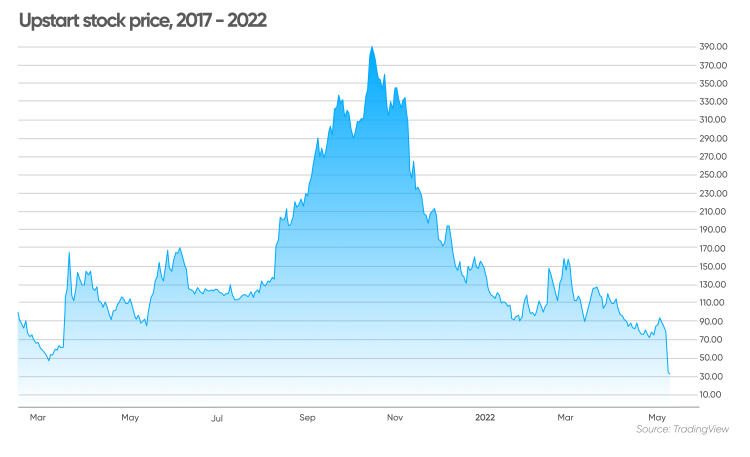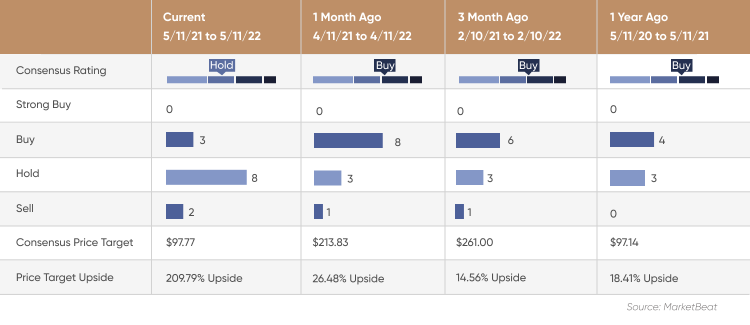Upstart stock forecast: Can the lending platform recover?

Upstart Holdings (UPST) is an artificial intelligence (AI) lending platform looking to disrupt traditional credit-score lending models.
Upstart’s platform uses machine learning to identify risk. It aims to improve access to affordable credit for borrowers while reducing the risk and cost of lending for its bank partners.
Upstart stock came to market in December 2020 at $20 a share and had soared to $390 by October 2021 – a 1,850% increase. But this bull run soon came to an end, and the stock currently sits (11 May) at $33.61.
In April, CEO Dave Girouard made the news as he sold off Upstart shares. The stock price was almost halved by disappointing first-quarter results released on 9 May. Amid a more hostile macroeconomic climate, what’s next for the Upstart Holdings (UPST) stock forecast?
Upstart stock analysis
Upstart (UPST) stock came to market on 16 December 2020 at an opening price of $20 a share. The price rose by 50% on the first day of trading, closing at $29.47. This growth continued, and by 1 February 202, the share price stood at $62.19 – a 211% increase on its initial public offering (IPO) level.
The price grew over the course of the spring and entered a bull run in late June 2021, when it rose from around $120 to an all-time high of $390 on 15 October. The stock was bolstered over this period by several banks launching personal loans platforms powered by Upstart, and the strong second-quarter results announced on 10 August 2021.
The stock entered a bear run in November 2021, triggered by mixed third-quarter results. Though headlines were good, investors were disappointed by revenue guidance issued for the quarter ahead.
Upstart reported year-over-year revenue growth of over 1,000% in Q2 2021. This had fallen to 200% for Q3, and the company issued guidance equivalent to 200% revenue growth for Q4.

February 2022 saw Upstart announce fourth-quarter and full-year results, and a share buyback programme. The market reacted favourably to the news and the share price jumped from $104.60 to $148.60 by day’s end on 16 February.
But these gains were short-lived. The share price dipped again, and tumbled in April when US Securities and Exchange Commission (SEC) filings revealed that CEO Dave Girouard had sold a significant amount of Upstart shares. Investors took flight, fearing bad news lay ahead, and the share price fell by almost 25% in the week following the news.
Disappointing first-quarter results released on 9 May did little to reassure investors, and the price plunged 46% in after-hours trading. In an earnings call, Girouard acknowledged the challenging macroeconomic climate facing the company, stating that “it’s become apparent that 2022 is shaping up to be a challenging one for the economy and for the financial services industry in particular”.
In terms of technical analysis for Upstart stock at the time of writing (12 May), the relative strength index (RSI) reading was 25.72, signifying that the stock was in oversold territory. The stock was trading significantly below its 10 and 20-day moving averages ($77.13 and $79, respectively), signalling a bear trend.
Results update
Upstart announced first quarter results on 9 May. Headlines were positive, but investors were disappointed by gloomy full-year guidance.
The company reported revenue of $310m, up 156% from $121m in the prior-year quarter. Net income was $32.7m, up from $10.1m in Q1 2021.
Earnings per share (EPS) of $0.61 represented a 122% increase on the prior-year quarter. According to data from MarketBeat, his figure beat analyst expectations by $0.08.
But Upstart (UPST) also issued updated guidance, stating it now expects projected revenues of approximately $1.25bn for FY22. This marks a significant downward revision of last quarter’s projections, when the firm expected revenues of approximately $1.4bn for FY22.
Challenging lending environment
These lower projections were driven by an increasingly hostile lending outlook. High US inflation is increasing the cost of living and this looks set to be coupled with sustained interest rate hikes. This combination could leave Upstart’s (UPST) customers struggling to meet repayments.
In the May earnings call, Girouard also warned that increased risk in the economy was raising loan prices on the platform and lowering demand.
“In addition to increasing rates for approved borrowers, this also has the effect of lowering approval rates for applicants on the margin. Given the hawkish signals from the Fed, we anticipate prices will move even higher later this year, which would have the effect of reducing our transaction volume, all else being equal,” he added.
CEO offloads shares
And amid this challenging climate, CEO Girouard has sold a significant number of Upstart shares. The most recent transaction was announced in a SEC filing in April 2022, and was followed by a share price tumble of 25%.
Investors can be spooked when executives sell shares in their company, fearing that it spells bad news ahead. What’s more, Girouard’s sell off came shortly weeks after an ambitious share buyback programme was announced – something that regulators have taken a dim view of.
In 2019, SEC Commissioner Robert Jackson was extremely critical of companies that announce buybacks at the same time as executives sell shares, stating: “When executives unload significant amounts of stock upon announcing a buyback, they often benefit from short-term price pops at the expense of long-term investors.”
His research into the relationship between stock buybacks and stock cashouts also found that “insider selling on buybacks is associated with worse long-term performance”.
Despite this, there are many mundane motivations for executives to sell shares, such as portfolio diversification. It is worth noting that Girouard did not address the transactions in the recent earnings call, but seemed at pains to stress his commitment to Upstart.
He stated: “I’m far too excited about — and paranoid about — the future to spend too much time toasting to our success in the past… At the same time, we have to pair this urgency about the present with optimism and absolute determination about the future.”
Upstart stock forecast for 2022
As of 11 May 2022, analysts rated Upstart stock a consensus ‘hold’. According to data from MarketBeat, Upstart stock had three ‘buy’ recommendations, eight ‘hold’ and two ‘sell’..
The average UPST stock forecast stood at $97.77 – a 209.79% upside on the share price at the time of writing (12 May). Analyst price targets ranged from a low of $28 to a high of $330.

Is Upstart a good stock to buy?
First-quarter results triggered a flurry of bearish analyst activity. On 11 May, Barclays downgraded the stock from ‘overweight’ to ‘equal weight’, while Atlantic Securities cut its price target from $245 to $45.
On 10 May, analysts at both Goldman Sachs and Bank of America downgraded UPST shares from a ‘buy’ to ‘neutral’ rating. On the same day, Wedbush’s Chiaverini halved their Upstart stock price target from $70 to $35.
Analysts at Stephens downgraded Upstart to an ‘underweight’ rating, and issued a $28 price target – a 63% downside on the report date share price. Analysts Citigroup also downgraded Upstart to ‘neutral’ and slashed their UPST stock price target from $180 to $50 – a 72% decrease.
Piper Sandler downgraded Upstart stock to a ‘neutral’ rating on 10 May and cut their price target from $230 to $44. This was an 81% decrease, representing a bearish 42.95% downside on the report date share price.
It’s worth noting that analysts’ predictions are frequently wrong and forecasts are no substitute for your own research. Always perform your own due diligence before investing. And never invest or trade money you can’t afford to lose.
Upstart stock price prediction 2022-2025
Looking to the longer term, algorithm-based forecasting service Wallet Investor rated UPST an “awesome long-term investment” at the time of writing (11 May).
Wallet Investor’s Upstart share price forecast suggested the price could rise to $128.85 by May 2023, $162.59 by May 2024, $200.95 by May 2025 and $240.56 by May 2026. Looking towards 2030, Wallet Investor’s 5 year forecast generated a price target of $274.80 for May 2027.
Note that algorithm-based price predictions can be wrong. Forecasts shouldn’t be used as a substitute for your own research. Always conduct your own due diligence before investing. And never invest or trade money you cannot afford to lose.
FAQs
Is Upstart stock a buy, sell or hold?
As of 11 May 2022, analysts rated Upstart (UPST) stock a consensus ‘hold’. According to data from MarketBeat, the stock had three ‘buy’ ratings, eight ‘hold’ and two ‘sell’ ratings. Note that analyst price forecasts can be wrong, and you should always conduct your own research.
Will Upstart stock go up or down?
As of 11 May, the average 12-month analyst price target for Upstart (UPST) stock was $97.77 – price targets ranged from $28 to $330, according to data from MarketBeat. Wallet Investor’s longer term algorithm-based forecasts suggested that the Upstart share price could reach $128.95 by May 2023, rising to $274.80 by May 2027. Note that price predictions can be wrong, and shouldn’t be used as a substitute to your own research.
Markets in this article
Related topics
